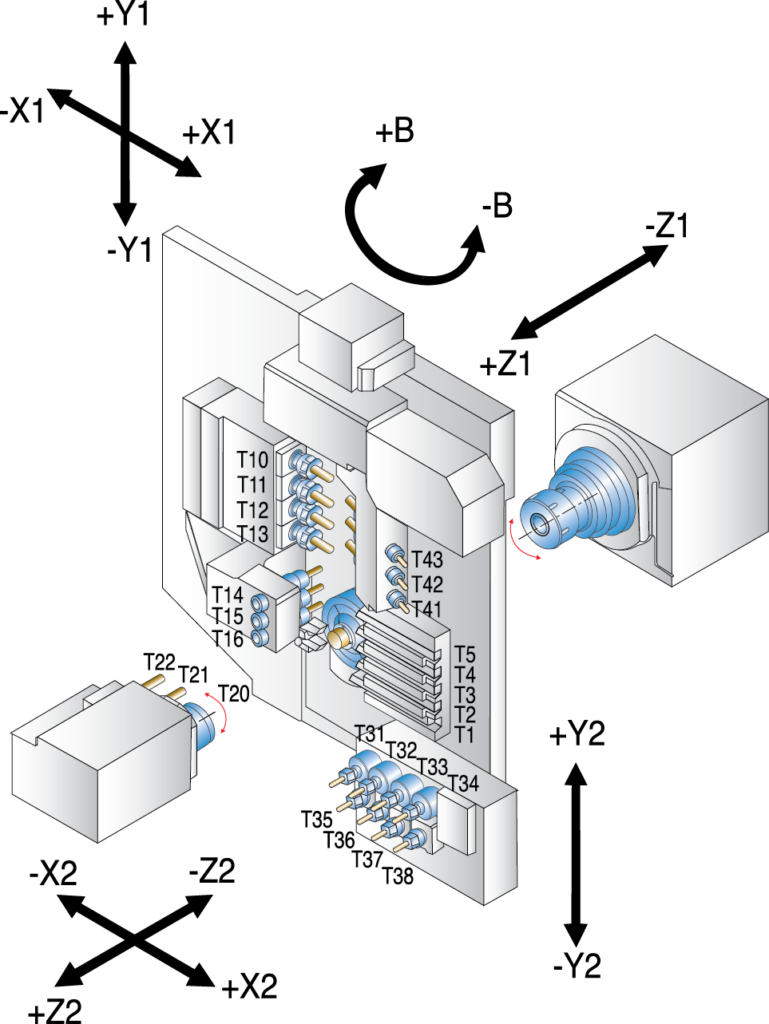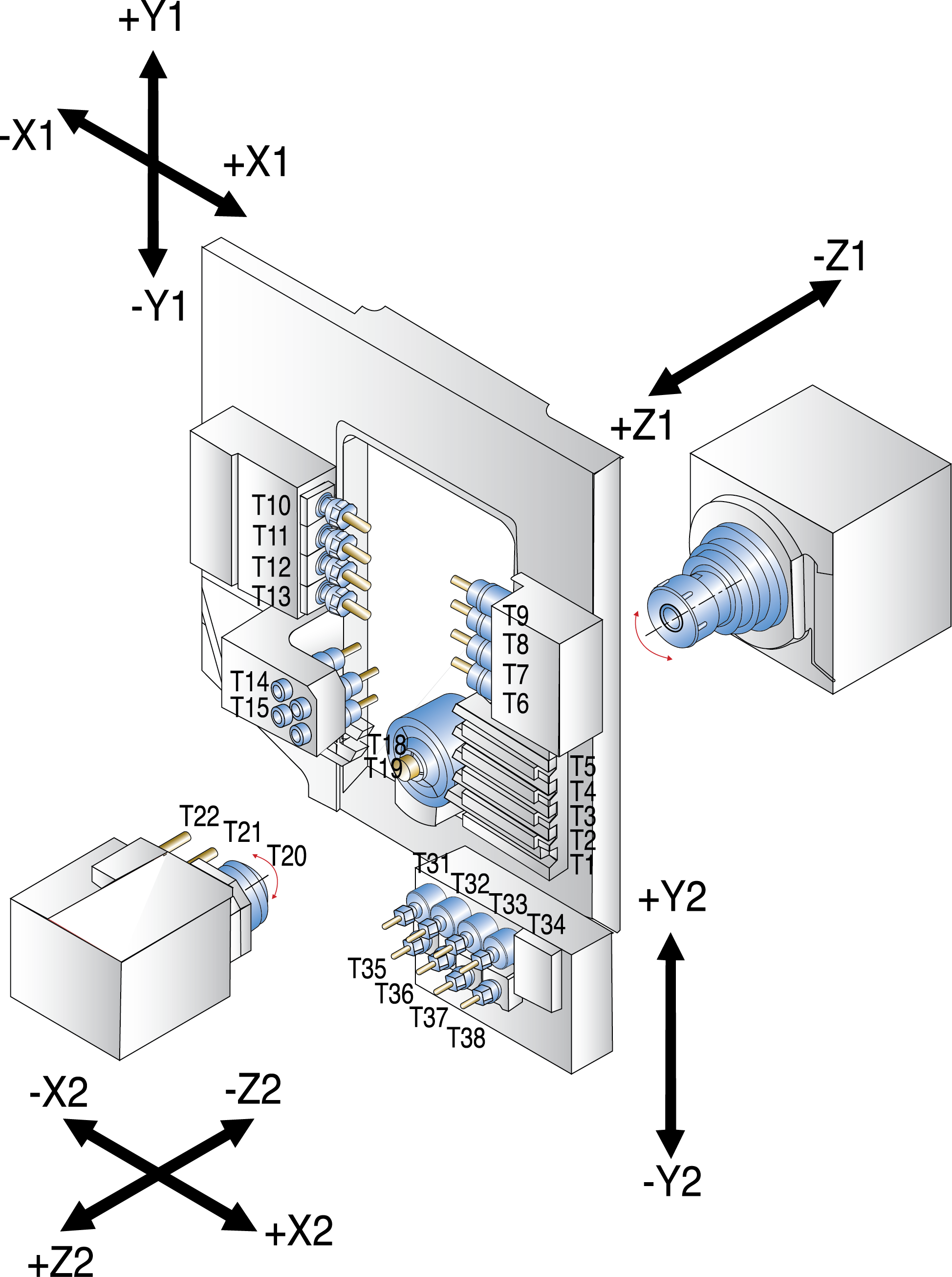Nexturn SA(XII) Series 8-Axis CNC Swiss-Type Lathes with Optional B-Axis
The Nexturn SA(XII) Series Swiss lathes — available in models SA-20XII (20 mm / 0.787”), SA-32XII (32 mm / 1.26”), and SA-51XII (51 mm / 2.00”) — delivers exceptional precision, rigidity, and performance for complex small-part production. Each machine is built for high-accuracy multitasking with up to 8 axes and an optional fully programmable 135° B-axis on the 20 mm and 32 mm models, providing 0°–135° of rotation for angled drilling, milling, and contouring.
With bar capacities from 20 to 51 mm and tooling configurations up to 33 tools, the SA(XII) line efficiently handles everything from intricate medical components to heavy-duty automotive and aerospace parts. Manufacturers in medical, aerospace & defense, automotive, electronics, and general precision turning industries rely on Nexturn for its unmatched combination of stability, accuracy, and ease of operation.
Competing directly with Marubeni Citizen-Cincom, Star, Mazak, Doosan, Tornos, Swiss-Tech, Swissturn, and Hanwha, Nexturn machines deliver cost-effective engineered solutions backed by Absolute Machine Tools’ automation and applications expertise.
Key Features
Specifications
| Item / Model |
SA-20XII
Request a Quote |
SA-32XII
Request a Quote |
SA-51XII
Request a Quote |
|---|---|---|---|
|
FREE TRACER 20 Bar Feeder |
FREE TRACER 32V Bar Feeder |
FREE TRACER 51V Bar Feeder | |
|
Number of Axes |
8 / 9 (opt.) |
8 / 9 (opt.) |
8 / 9 (opt.) |
|
Number of Channels |
2 |
2 |
2 |
|
Bar Capacity (Front/Rear) |
20 mm / 20 mm |
32 mm / 32 mm |
51 mm / 51 mm |
|
Max. Turn Length |
11″ |
11″ |
5.9″ |
|
Guide Bushing Type |
Synchronous |
Synchronous |
None |
|
Main Spindle |
5 HP / 10,000 RPM |
10 HP / 8,000 RPM |
17.5 HP / 6,000 RPM |
|
Sub Spindle |
3 HP / 8,000 RPM |
3 HP / 8,000 RPM |
20 HP / 6,000 RPM |
|
Total Tools |
31 / 29 |
31 / 29 |
22 |
|
Fixed Tools (Front/Rear) |
11 / 4 |
11 / 4 |
10 / 3 |
|
Live Tools (Front/Rear) |
12 / 10 |
12 / 10 |
6 |
|
Live Tools (Rear) |
4 |
4 |
3 |
|
Cross Live Tools |
1.3 HP / 6,000 RPM |
1.3 HP / 6,000 RPM |
3 HP / 6,000 RPM |
|
Backend Live Tools |
1.3 HP / 6,000 RPM |
1.3 HP / 6,000 RPM |
1.3 HP / 6,000 RPM |
|
B Axis |
0 – 135º |
0 – 135º |
0 – 135º |
|
C Axis Contouring |
Main/Sub |
Main/Sub |
Main/Sub |
|
CNC Control |
FANUC 31iT |
FANUC 31iT |
FANUC 31iT |
|
Weight |
7,920 lbs. |
8,140 lbs. |
9,240 lbs. |
Benefits for Metal Cutting Manufacturers
Together, these features allow manufacturers to produce tight-tolerance parts with superior surface finishes, reduced setup times, and greater profitability in competitive production environments.
Ideal Cutting Applications
FAQs
How does a CNC Swiss machine work?
As the turning process begins on a CNC Swiss machine, the main spindle unchucks the workpiece, giving the operator the amount of stroke needed based on the length of the part. The guide bushing continues to feed material into the tooling to create the desired features. The close geometry construction of the machine allows the tool to work within millimeters of the workpiece, reducing chip-to-chip time to a second or less. Using a guide bushing allows a tool to take a heavier depth of cut on the part itself without jeopardizing tolerances. Then, the machine performs a pick off process with the sub-spindle side. If there are any secondary operations to be done on the back of the part, this can be achieved here at the sub. The part is then dropped into a conveyor, which ejects it out the front of the sub.
What is a guide bushing?
The rotary guide bushing, originally called an anti-friction guide bushing, was patented in 1963 to hold various diameters of bar stock for automatic screw machines. The guide bushing rotates the workpiece and pushes it into and out of the cutting tool. It was found to be particularly adaptable for use in a Swiss-type automatic screw machine, which are generally provided with a headstock movable axially to the machine frame while rotating the bar stock. Having an adjustable bushing allows for turning bar stock rigidly and close to the turning tools, which makes it possible to machine parts with high quality finishes and extreme accuracies. A rotary guide bushing rotates with the workpiece and is ideal for turning wider parts, with tolerances greater than +/-0.0005”. Fixed guide bushings remain stationary while the bar stock spins and are ideal for parts that require tighter tolerances.
How many axes does a Swiss lathe have?
While the number of axes can vary depending on the options, most conventional Swiss lathes have 7-9 axes. For instance, the Nexturn SA(XII) series feature up to 8 axes and up to 29 total tools, increasing to 9 axes with the B-axis.






